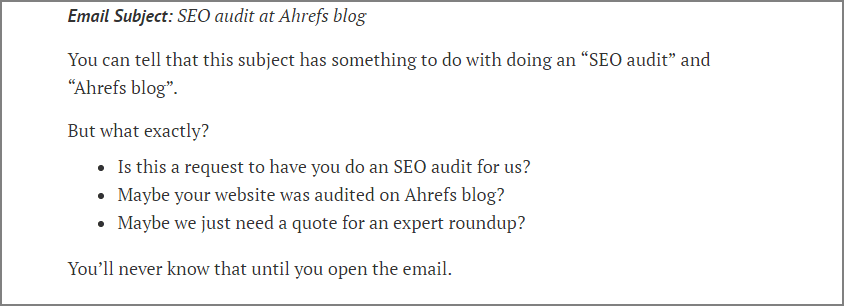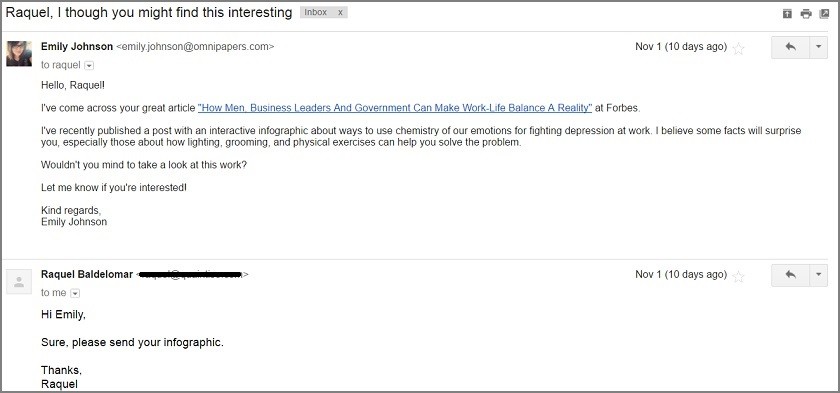
7 Effective Email Outreach Tactics To Get More Replies
This problem is as old as Adam:
Online marketers send tons of outreach emails to connect with influencers, let them know about content, ask for backlinks, or get any other marketing goal. They learn and implement different tactics to increase open rates and get more replies, but big fish isn't yet in a hurry to swallow the bait.
Back in 2012, Rand Fishkin cut it up into little pieces for marketers to eat: he explained what separated good emails from great ones, shared tips on standing out from competitors, and hinted how to inspire recipients to respond.
2016 is nearly over, but the cart remains there still. Marketers continue reading and implementing tons of outreach tactics, but most their emails drive influencers nuts all the same.
Why?
Those emails are poorly structured.
Those emails look like a template, reminding nothing but spam.
Let's face it:
Who hasn't read outreach tips from Brian Dean, Tim Soulo, Lesley Vos and other bloggers sharing the examples of their emails and hasn't tried to use them as templates?
Raise your hand!
The result? Influencers start getting tons of same-looking outreach emails.
How do you like it, huh?
It comes as a no surprise that they don't hurry to respond.
Besides, reaching out different people the same way would be the dumbest thing for a professional marketer to do. As well as you use different tactics to optimize content for different target audiences, you might want to consider different email outreach tactics, depending on your recipient and desired results.
The below seven are your one-way ticket to awesomeness.
Use Professional Email Address
Sounds too obvious?
Not really, given that many of us continue getting emails from lilly321@hotmail.com or rupinder1985@gmail.com. Yes, in 2016!
Be sure to select an appropriately named and professional email address. First, it will allow you to avoid getting into spam or promotion folders of the recipient; and second, it will form an opinion of you being a competent person.
Gmail or a domain-branded address enhances your email's chances of opening, as a minimum.
Also, think of using the right signature.
Influencers get tons of emails daily, so make it clear who you are. Even if you met before and they promised to help, big chances are they don't remember you. Put your name, company, and job position to your email signature. Your phone number and website URL rule as well because they make it easier for recipients to browse you and decide if you are a good fit.
Think On Appealing Subject Line
To get a reply, you first need to do your best and make recipients open your emails.
Easier said than done.
Did you know that 78% of all sent marketing emails get nothing? Not encouraging enough, but that's just the point.
A subject line matters as it's the first thing people read when getting your emails. It helps recipients decide whether they want to open and continue reading, and your task is to spark their interest.
Certainly, there's no one-works-for-all magical formula to writing the perfect subject line, but you might want to consider several tricks for making it more appealing.
Trick: a recipient's name
Emails with "personalized subject lines are 22.2% more likely to be opened." Nothing supernatural, just psychology: according to the study, a sound of our names evokes a unique reaction in our brain that triggers its greater activation. Dale Carnegie understood that magic when suggested to call people by name in his book How to Win Friends and Influence People.
Example:

But it's not all that simple.
The recipient's name itself doesn't guarantee they will open and read your email.
Trick: a bit of intrigue
As Tim Soulo wrote in his article for Ahrefs blog, your favorite approach to writing subject lines might be sparkling "a little bit of intrigue". Don't make it 100% obvious for recipients so they might want to open your email for more details.
That's the example he provides:

According to the research from MarketingProfs, the highest read rate comes from emails with subject lines of 51-60 characters and 6-10 words length. So, don't be too vague or irrelevant, too formal or informal, too dense or scared.
Make It Personal
As Neil Patel says, "no one wants to be templated".
Getting hundreds of twin emails daily, why should influencers care about yours if it looks the same? On the flip side, personalized emails are hard to ignore. Citing Tim Soulo, a blogger would "feel like a total ass" if didn't respond to them.
To make a long story short, personalize every single email you send.
How?
Spend time on learning more details about a recipient and show that in your email. But avoid cliches such as "I'm your big fan" or "I've been reading your blog for a long time", especially if it was yesterday when you first liked or retweeted them.
Don't be too self-concentrated. Would you talk to anyone who cares about nothing but their wants and needs? Writing your outreach email, think of what’s in it for a receiver. Avoid anything like "I believe your readers will love it" because, frankly speaking, it has nothing beneficial for the person you're emailing.
As has been said, address a recipient by name whenever possible. Also, use direct language: less "I", more "you".
Think of your email as conversation. Avoid gobbledygook, write the way you talk, but don't be too informal: "buddy", "dude", and other lousy words will send your email to a rubbish bin.
Write Pithily
That's about a fine line between being clear and being pushy.
You know that influencers are busy people, and you do your best to avoid ambiguous statements and vague sentences in outreach emails. "So, what do you want from me?" is not the reaction you want to obtain from recipients.
Write pithily and try to adhere to the formula "one email - one ask." Keep it simple.
Your word to remember here is BALANCE; otherwise, your outreach email risks turning into impudent demand:
Check my article.
Share it with followers.
Review my product.
Let me know what you think of it.
Wait, wha-a-at? It doesn't take a Sherlock Holmes to detect that influencers would hardly reply emails structured this way.
The bestselling author of Give and Take, Adam Grant says that his "least favorite emails made demands instead of expressing appreciation." So, before contacting anyone, figure out exactly what you want, stick to one please per communication, and make sure you don't sound brazen or demanding.
Keep your outreach email humble.
Use Right Words
Words do wonders. When used correctly, they can become your weapon of creating compelling outreach emails. More than that, your words can influence recipients and make them feel a certain way.
For this to work, words should be powerful. First of all, answer these two questions:
Does your email have a strong information scent?
Does your email have a surplus value?
Influencers don't have time to read everybody and anybody. Why should they choose your email among others? What's in there for them to care?
Make it easier for recipients to see the value of your outreach by including visual and informational clues to emails. A reader should "smell" and notice the "meat" while scanning your email to decide if it's worth the bother.
How?
Short sentences.
Short paragraphs.
No plague words.
Active verbs.
No jargon.
No raw URLs.
No cliches!
The last of these not only frustrate but scare recipients.
Make It Short
Fewer words maximize conversions, and this rule works for emails, too.
When it comes to online communication, "less is more" becomes a golden rule for marketers. Follow the 3-5-7 rule of email copywriting: you have three seconds to get attention, five seconds to draw readers in, and seven seconds to compel action.
Three to five short paragraphs per letter seem perfect. Anything longer can decrease your chances of getting a response.
Here is the example of outreach email with 76% response rate. Omni Papers did it right, keeping it short, personalized, and with a value for recipients:

Send in Right Time
The case study on creating and promoting content via outreach mentioned the significance of time for sending emails. Timing matters, and the best email marketing campaigns prove that:
The best days to send emails: Tuesday, Wednesday, and Thursday.
The best time to send emails: 6 a.m., 10 a.m, and 2 p.m.
The problem is, tons of data from different studies exist on the topic, and some of them provide completely different results. What should you do? Whom to trust?
The best decision would be A/B testing: experiment with sending time to check the exact best one for your email list. What works for one marketer won't necessarily work for another one. Armed with the right information, you can get the idea of where to move next.
Don't burn bridges before you've built them. Before sending an email, make sure that:
It's not about you but a recipient.
It's short and sweet.
It's relevant and to the point.
It's incentive.
It's persuasive but not demanding.
It has nothing in common with SEO and link building.
And remember: being persistent is good, but don't send too many follow-ups. No one likes annoying people, and that's the very situation when your persistence can play Old Harry with you and result in hurting your reputation.
It's high time to delete your templates and start giving a value.
Do you agree?
Note: The opinions expressed in this article are the views of the author, and not necessarily the views of Caphyon, its staff, or its partners.
Article by
Emily Johnson
OmniPapers blogger and guest writer, Emily specializes in blogging, digital and content marketing. Contributor to many websites like ProBlogger, Smart Insights, and others. You can find Emily on Twitter.
stay in the loop





